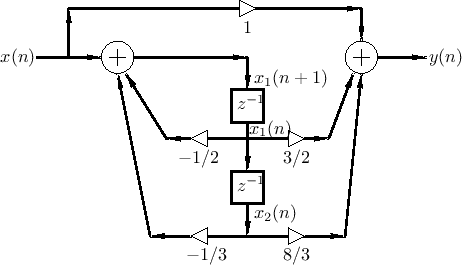 |
For the example of the previous section, suppose we are given Eq.(G.14) in direct-form II (DF-II), as shown in Fig.G.1. It is important that the filter representation be canonical with respect to delay, i.e., that the number of delay elements equals the order of the filter. Then the third step (writing down controller canonical form by inspection) may be replaced by the following more general procedure:
 |
The state-space description of the difference equation in Eq.(G.7) is given by Eq.(G.16). We see that controller canonical form follows immediately from the direct-form-II digital filter realization, which is fundamentally an all-pole filter followed by an all-zero (FIR) filter (see §9.1.2). By starting instead from the transposed direct-form-II (TDF-II) structure, the observer canonical form is obtained [28, p. 87]. This is because the zeros effectively precede the poles in a TDF-II realization, so that they may introduce nulls in the input spectrum, but they cannot cancel output from the poles (e.g., from initial conditions). Since the other two digital-filter direct forms (DF-I and TDF-I--see Chapter 9 for details) are not canonical with respect to delay, they are not used as a basis for deriving state-space models.